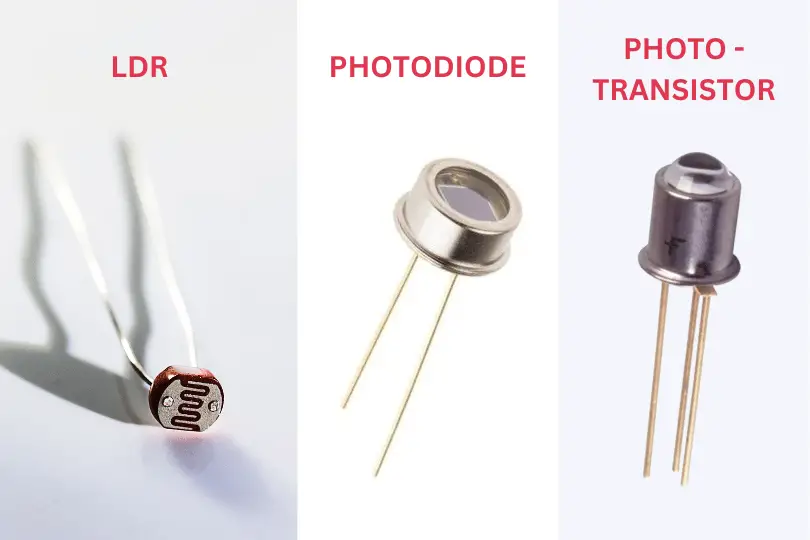LDR vs Photodiode vs Phototransistor comparison
In electronic projects or different electronic devices, light detection and light-to-electricity conversion comes critical importance for various functions and applications. Here we are comparing three commonly used light sensor components – Light Dependent Resistors (LDRs), Photodiodes, and Phototransistors, to provide a comprehensive understanding of these components, their differences, uses, and applications.

Light Dependent Resistor (LDR)
An LDR is a passive electronic component that has a resistance that varies with the intensity of the incident light. LDRs are made of high resistance semiconductors. If light falling on the device is of high enough frequency, photons absorbed by the semiconductor give bound electrons enough energy to jump into the conduction band. The resulting free electrons conduct electricity, thereby lowering resistance.
LDRs are used in light and dark detection applications, such as in street lighting systems. They are also used in camera light meters, clock radios, alarm devices, night lights, outdoor clocks, solar street lamps, and many more.
Photodiode
A photodiode is a semiconductor device that converts light into an electrical current. The current is generated when photons are absorbed in the photodiode. Photodiodes may contain optical filters, built-in lenses, and may have large or small surface areas. Photodiodes usually have a slower response time as their surface area increases.
Photodiodes have a wide range of applications including smoke detectors, compact disc players, medical devices, and many more. They are also used in telecommunications networks and in analog and digital signal processing.
Phototransistor
A phototransistor is a type of photodiode. It is a light-sensitive transistor where the base-collector current is controlled by the amount of light hitting the base-emitter junction. The absorbed light generates an electron-hole pair, and these carriers are swept into the collector region under the action of the base-collector electric field, thus generating photocurrent.
Phototransistors are used in various applications including computer logic circuits, light detection systems, and digital signal processing. They are also used in the fields of automation, industrial controls, and many more.
Which one to choose?
Choosing between an LDR, Photodiode, and Phototransistor depends on the specific requirements of your application. Here are some factors to consider:
- Sensitivity and Speed: If your application requires high sensitivity and speed, a photodiode would be a good choice. Photodiodes are known for their quick response times and high sensitivity to light.
- Light Intensity: If you’re working with an application that involves varying light intensities, an LDR could be the right choice. LDRs are known for their ability to adjust their resistance based on the intensity of light they receive.
- Signal Amplification: If your application requires signal amplification, a phototransistor would be the best choice. Phototransistors not only detect light but also amplify the signal, making them ideal for applications that require both light detection and signal amplification.
- Cost and Complexity: LDRs are generally cheaper and simpler to use than photodiodes or phototransistors. If cost or simplicity is a major factor, an LDR might be the best choice.
- Environmental Conditions: The operating environment can also influence your choice. For example, photodiodes and phototransistors are more suitable for environments with high temperatures and frequencies, while LDRs are better suited for lower temperatures and frequencies.
While LDRs, Photodiodes, and Phototransistors all serve the purpose of detecting and responding to light, they each have unique characteristics and are suited to different applications. Understanding these differences is key to selecting the right component for your specific needs. Whether it’s the simple operation and cost-effectiveness of an LDR, the speed and sensitivity of a photodiode, or the amplification capabilities of a phototransistor, each component is useful in its own ways.